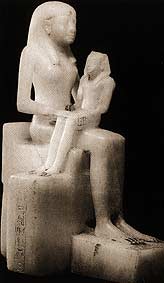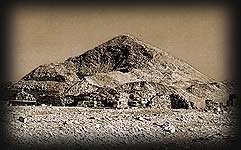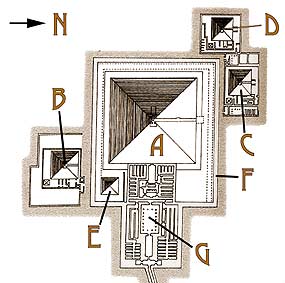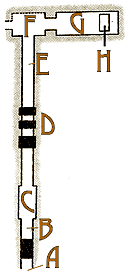 |
The
longest reigning pharaoh of ancient Egypt - he ruled Egypt for
94 years. He inherited the throne while he was only 6 after the
death of his half-brother Merenre. During these early years his
mother, Queen Ankhnesmerire acted as regent - an alabaster statuette
shows this close relantionship.
Pepi II is known to have
married his half-sister, Neith (daughter of Ankhnesmerire I),
he also married his niece Ipwet (daughter of Merenre), as well
as two other senior queens (three of these queens were buried
within their own pyramids within the pyramid complex of Pepi
II).
|
Foreign
relantions
Inscriptions in the tomb of the official Harkhuf (see below)
gives good evidence of Egypt's relantions with Nubia broken
alabaster vases found at Kerma in the Sudan also indicates that
Egypt may have had a trading centre deep into Nubia during the
times of Pepi I, Merenre and Pepi II. Trading expeditions were
also being sent to Byblos in Syria (vase fragments with the names
of Pepi I and Pepi II were found here). Activity has also been
found dating to Pepi II's reign in the mines at Sinai other
foreign trading expeditions were also widely known to have existed.
There is evidence to show that during this period the borders
of Egypt were also under threat there were inter-tribal
troubles in Nubia, and the Asiatics were probing Egypt's north-eastern
border.
Inscription
from the tomb of Harkhuf
The tomb of this nobleman
at Aswan gives and interesting insight of a message sent by a
young Pepi II to Harkhuf (Year 2)- firstly, Harkhuf made several
journeys into Nubia to collect ivory, ebony, incense and other
precious items for the Egyptian market. It was while on one of
these trading expeditions that Harkhuf captured a small pygmy,
once the royal court had been informed Pepi II himself sent a
letter to Harkhuf :
The
King's own seal: Year 2, third month of the first season, day
15. The King's decree to the Sole companion, Lector-priest, Chief
of scouts, Harkhuf. Notice has been taken of this dispatch of
yours which you made for the King at the Palace, to let one know
that you have come down in safety from Yam with the army that
was with you. You have said in this dispatch of yours that you
have brought all kinds of great and beautiful gifts, which Hathor
mistress of Imaau has given to the ka of King Neferkare, who
lives forever. You have said in this dispatch of yours that you
have brought a pygmy of the god's dances from the land of the
horizon-dwellers, like the pygmy whom the god's seal-bearer Bawerded
brought from Punt in the time of King Isesi. You have said to
my majesty that his like has never been brought by anyone who
did Yam previously.
Truly you know how to do what your lord loves and praises. Truly
you spend day and night planning to do what your lord loves,
praises, and commands. His majesty will provide your many worthy
honours for the benefit of your son's son for all time, so that
all people will say, when they hear what my majesty did for you:
"Does anything equal what was done for the sole companion
Harkhuf when he came down from Yam, on account of the vigilance
he showed in doing what his lord loved, praised, and commanded?"
Come north to the residence at once! Hurry and bring with you
this pygmy whom you brought from the land of the horizon-dwellers
live, hale, and healthy, for the dances of the god, to gladden
the heart, to delight the heart of King Neferkare who lives forever!
When he goes down with you into the ship, get worthy men to be
around him on deck, lest he fall into the water! When he lies
down at night, get worthy men to lie around him in his tent.
Inspect ten times at night! My majesty desires to see this pygmy
more than the gifts of the mine-land and of Punt!
When you arrive at the residence and this pygmy is with you live,
hale, and healthy, my majesty will do great things for you, more
than was done for the god's seal-bearer Bawerded in the time
of King Isesi, in accordance with my majesty's wish to see this
pygmy. Orders have been brought to the chief of the new towns
and the companion, overseer of priests to command that supplies
be furnished from what is under the charge of each from every
storage depot and every temple that has not been exempted. |
 |
The decline
of Royal Power and the descent into chaos
Much has been made of
Pepi II's great age when he died, it is this thought that as
he got increasingly older Pepi was no longer able to control
the ambitions of the nobility in Egypt. The nobility held their
own land which was passed down from father to son, bigger tombs
were cut for them - their own nomes grew in importance also and
only a casual allegiance was given to the crown. Further strain
was put on the throne by the needs of the royal pyramid and solar
temples - eventually the Old Kingdom society would collapse into
the chaos of the First Intermediate Period, a time when Egypt
would be without a one true king.
There is, however, a
mention of a successor to Pepi II - Merenre II (son of Pepi II
and Neith), and Queen Nitocris (thought to have been the wife
of Merenre II, but could also have ruled in her own right).
The
Pyramid of Pepi II
('Pepi
is most stable in Life')
Original
Height - 52.5 m
Length
of Side - 78.5m
|
 |
Pepi II was the last
pharaoh of the Old Kingdom to build the 'classic' style pyramid
complex, the mortuary temple depicts food and many other items
which Pepi II would need in the Afterlife. The pyramid is south
of Saqqara and was first excavated by Gustave Jequier in 1929.

| A
- Pyramid of Pepi II |
E
- Satellite pyramid |
| B - Pyramid
of Queen Udjebten |
F
- Enclosure Wall |
| C
- Pyramid of Queen Neit |
G
- Funerary Temple |
| D
- Pyramid of Queen Ipuit |
|
|

Burial
chambers within the pyramid
| A
- Entrance |
E
- corridor |
| B - First
Corridor |
F
- Antechamber |
| C
- Vestibule |
G
- Burial Chamber |
| D
- Granite slabs |
H - Sarcophagus |
|
For details on the Pyramids of Pepi II's Queens - CLICK HERE
|







